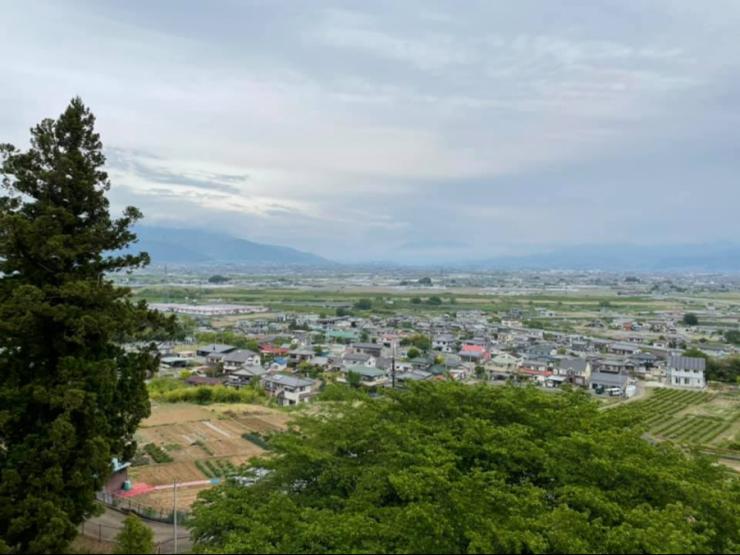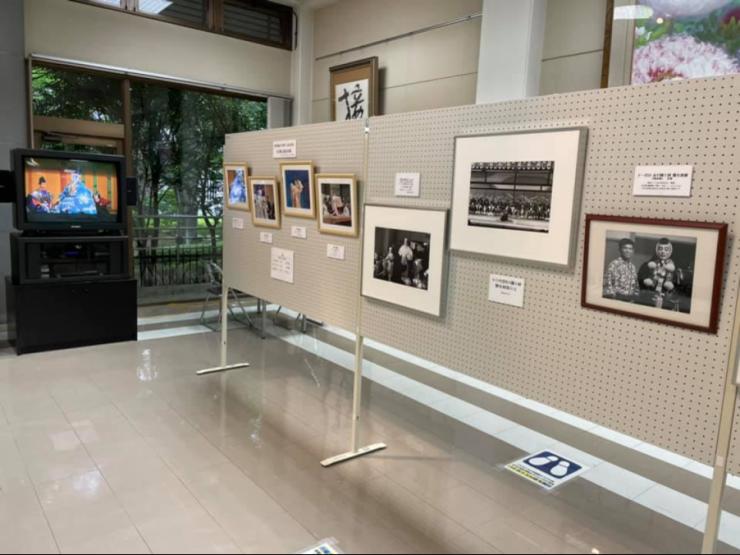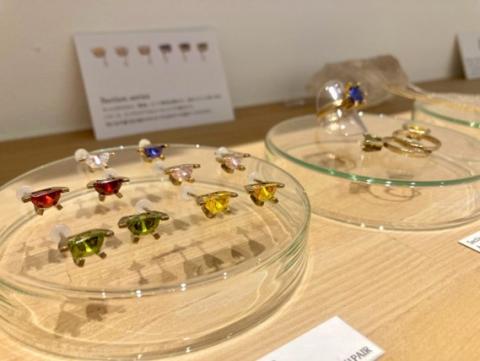Main content starts here.
Gateway to Ichikawa
Kabuki is a Japanese art form that originated in the 17th century based on previous art forms before it. Originally, it was believed to have been created by a woman known as Izumo no Okuni, a shrine maiden from Izumo Taisha, a famous shrine located in Shimane Prefecture. Okuni formed a troupe to promote Izumo Taisha and toured the country with her performative dance, which caught on quickly throughout the country. However, due to the patriarchal society that Japan was at the time, women were forbidden to appear on stage and Kabuki became a male-only tradition. The first generation of the Ichikawa Danjuro family, regarded as the most prestigious and essential family in the Kabuki world, created the “Aragoto” style during the Edo period and established various other basic artistic styles related to the kabuki. The art and techniques have been inherited by the prominent Danjuro family and various other families. The presentation of a dynamic theater that was open to everyone from all levels of society still remained as one of Japan’s cultural landmarks: Ichimura Manjiro (2006) states ”Indeed, Kabuki is a microcosm of the diverse nature of Japanese culture. I would like to continuously make an attempt to use kabuki like the table of contents of a book, as a doorway to Japan.”
As someone who grew up surrounded by performance arts which emphasize leisurely and methodical movements, Kabuki amazes me with the wonderment. Their dynamic poses, poetic vocal performance, and their symbolic and powerful appearance make up an apparatus of excellent performance theater. Compared to the usual Western performance that I was trained in, which was more narrative theratics, Kabuki captures the feeling of a moving painting illustrating a classical story. The difference lies in the actor’s visual acting, whereas Western based acting traditions are more concerned with the focused on the fourth wall aspect of realism, where performers are expected to act as realistic as possible and to avoid mistakes that can ruin the fourth wall between the play and the audience. The play is more grounded and offers less over the top movements as well with the plays that I performed. Kabuki, on the other hand, accepts that it is a performance and is more focused on capturing the beauty of the stage and the performance. I was more than determined to learn more about the arts and craft of how Kabuki can continue to capture peoples’ interests so that I could one day hope to capture even a sliver of the standard of performance perfection that Kabuki delivers. It was that desire that brought me to the birthplace of Ichikawa Danjuro and Edo Kabuki, the Kabuki Bunka Museum, also known as the Ichikawamisatocho Bunka Museum located in Ichikawa Misato-cho, a town famous for fireworks and Japanese paper.
It was a short hike up a relatively steep mountain from the Kai Ueno station. One could feel rural Japan at the core, as it is surrounded by woods away from the city. The smell of fresh rain filled the area, as I trekked up after my group. I pondered whether the fatigue that goes with hiking hills would last hours, but it was shorter than I had expected. Not before long, we encountered a shrine known as Kekisakushinsha out front. It stood on top of the hill as if it was welcoming us from the hike. To the right of the temple, was a small playground known as the Kabuki Park, a vital land of the Kabuki ancestors. We stopped for everyone to catch up from quite a short but steep trek. From behind the temple was a pathway that led to a view overlooking the small town of Ichikawamisatocho. However, you can get a better view if you enter the castle which houses a cultural museum housing some old artifacts and was once a Kabuki theater that was performed by the renowned Ichikawa family.

(Pictures taken by Darren Jon Ashmore, May 7th 2021)

(Pictures taken by Darren Jon Ashmore, May 7th 2021)
The Ichikawa family was a name that I was vaguely familiar with at the time, mostly through some cultural references made in games and anime. Most would be aware that they are part of the greater Kabuki dynasty that has been passed down through generations, but it wasn’t until we finished with the cultural museum visit that we traveled eastward, where we would truly learn their wild legacy. Rain, once again, fell, foreshadowed by its ubiquitous scent; thankfully, the rain was brief in its appearance. We trekked through the garden, which invoked the feeling of the old Edo Kabuki era, led by a stone path surrounded by old buildings that once used to house Kabuki equipment and practice locations. Our group arrived at a quaint building, almost humble and uninteresting in it’s presentation but filled with posters and stands detailing the latest Kabuki play performed by the upcoming Ichikawa Ebizō XI, the current successor to the main Ichikawa Danjūrō dynasty. We entered and were greeted by two senior citizens who have dedicated themselves to taking care of the cultural museum and act as tour guides to the Kabuki history of the Ichikawa Danjūrō family. We gave our tickets, took off our shoes, and put on some, quite frankly, small slippers that almost didn't fit my feet as we prepared ourselves to learn the important aspects of Kabuki acting and the legend of Ichikawa Danjūrō.

(Pictures taken by Darren Jon Ashmore, May 7th 2021)
The floor was filled with monuments and photos to commemorate visits from Danjuro the 10th, 11th, and 12th to the town and posters of the successor, Ebizo the 11th. We walked past a decorated stage of wax figures to the left of us, based on the image of the multiple Ichikawa Danjūrō, while to the right were various face paintings worn by the Ichikawa family that seemed to be plastered onto a wet sheet of paper after a performance. It was a reproduction of the stage. “Kabuki 18 Sukeroku '' created by Ichikawa Danjūrō VII. We were led into a small room to view a short video detailing the legacy of the Ichikawa Danjūrō dynasty, and shown footage of various modern Ichikawa figures, namely Ichikawa Danjūrō XII. After the brief video, we were brought back to listen to a talk which was an overview of the family as whole and the aspects about the various different oshikuma, made by pressing kuma-dori onto Japanese paper after a special performance. There were various different oshikuma from all sorts of plays that were once performed in Ichikawamisatocho. As the guide continued to explain many different branches of the Ichikawa family ancestors, I decided to take a closer look at one of Ichikawa wax figures from the Sukeroku stage. Their angry and stern expressions screamed out to me, as my heart shivered for a second before the brain reminded me that it is not real. I recall a scene from Yoshitsune and the Thousand Cherry Trees (義経千本桜), a famous kabuki play regarding the tales of the Genji warrior, Minamoto no Yoshitune as he fled from his treacherous brother. The Heian period is one of the hallmarks of Japanese classical cultural myth and history. The actor who plays Yoshitsune was covered in white foundation and had his eyes painted red. Red often symbolises passion and heroics. It’s small and somewhat simple symbolism, but it is part of the simplicity is why it's effective. The heart-throbbing performance, decorated in red, as a hero faces their demons literally or figuratively. It’s how color is symbolized as they are today. It is easy to recognize that even children can understand who is who. It isn’t the same as decoding the complexities of something like the motives of Shakesphere’s Iago in Othello, it’s a show that is understandable to people from all walks of life.
We were then led past the main hall and into a large room that held large Ukiyo-E portraits of generations of the Ichikawa Danjūrō family and their various costumes and props that are exclusive to this museum. The center rectangle is a collection of merchandise and news clips that were sold around the various time periods that Ichikawa performed, supported by a nearby university. I thought about the current Kabuki performance that we were practicing to perform. Although amateurish compared to anything the Ichikawas have done, the impact of seeing their monumental impact on their legacy throughout the time period was a strange feeling. My stage fright was almost suffocating as the pressure built from these expectations, but perhaps that was always how it ended up being. Kabuki actors were able to overcome their difficulties through their performance. The compassion of figures such as Benkei and Yoshisune from “Kanjicho”, the kindness of the Japanese people, the richness of their hearts, and their sense of morality allowed Kabuki to flourish into the modern age. A way that teaches the way of the people since the Edo period that once said “You don’t have to go to school to perform Kabuki.”
By committing oneself to high standards, the payoff is a legacy that can be mapped throughout the periods of Japan. It is a practice that not everyone can reach, but a passionate desire to do so is one that would make the fore-bearers of Kabuki, Ichikawa Danjūrōs at least content to see replicated.
Ichikawa Misato Chō Town Official Website (Japanese):
http://www.town.ichikawamisato.yamanashi.jp/50sightsee/50guide/kabukibunkakouen.html
References:
Ashmore, Darren Jon. Pictures of Kabuki Bunka Museum. Kabukibunka Park, Kai Ueno, 7 May 2021.
Ichimura, Manjiro. “Kabuki as Japanese Culture.” JAPAN SPOTLIGHT, 2006,
www.jef.or.jp/journal/pdf/gallery_0607.pdf
T.L.
Published on
- May 25, 2022
Share
-

The Golden Peak (金峰山―Kinpusan) of Yamanashi
May 23, 2025
-

May 23, 2025
Home of Mt. Fuji > Kaleidoscope Students Journal > Gateway to Ichikawa
